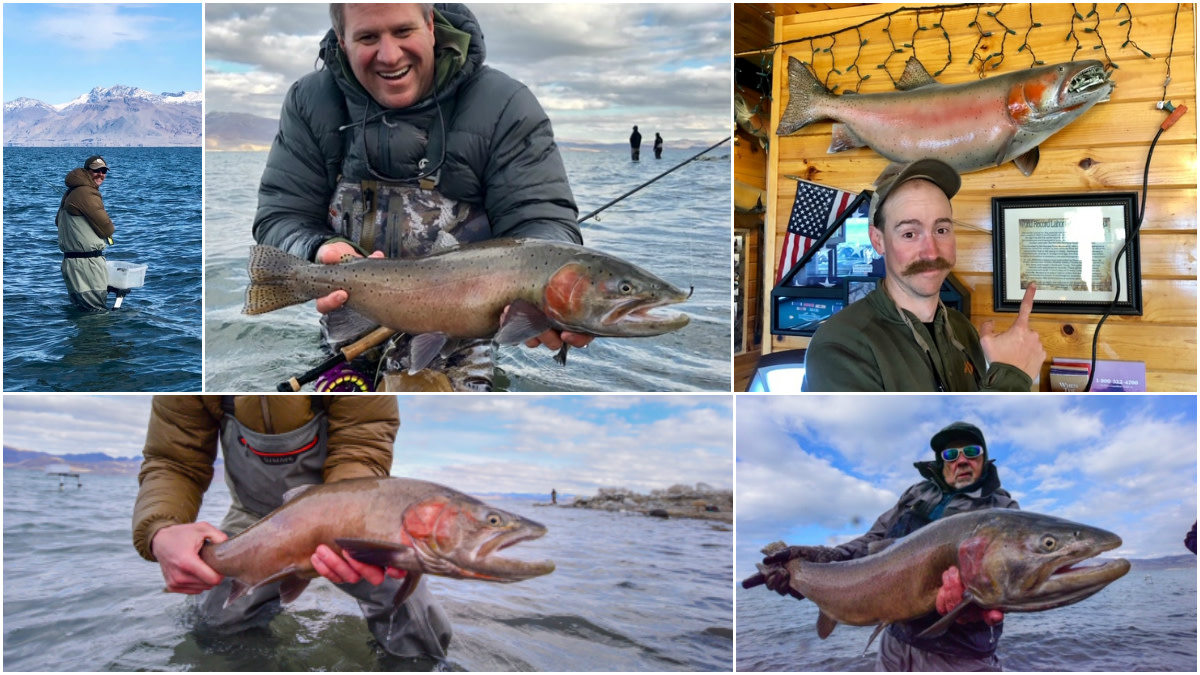
Pyramid Lake is a bit of an oddity. Settled against the bleak backdrop of high desert, there isn’t a tree in sight. Instead, exposed bedrock, sage brush and tarantulas surround the lake. It hardly announces itself as a trout fishing mecca.
I first fished Pyramid in the winter of 2007. A buddy and I grabbed ladders and lined up on the beach side of Pelican Point with about 25 other Gore-tex-shelled hopefuls. The whole scene was intimidating: the size of the lake, the wind and the vast array of stiff-bodied anglers standing atop aluminum perches. My hopes weren’t high.
Standing on ladders improved our chances of casting to the drop off and allowed us an angle to see down into the turquoise-blue water. The first giant swam by solo and languid. Another followed. Soon packs of fish crossed from left and right, patrolling the edge of the abyss. My casts started choppy and rushed, but after about an hour I settled into a rhythm and connected with my first Lahontan cutthroat, a fish of 6 or 7 pounds with a prehistoric past.
It was a pretty typical specimen by Pyramid standards, but a trophy in my book. That’s when I started to understand how special this place is.
“Salmon trout,” “desert dinosaur” and “50 pounder,” the Lahontan cutthroat trout of the Western United States carry a mythology unique in the world of trout. When I first moved to Truckee 13 years ago, I had no idea I was entering the historic territory of one of the most iconic salmonid species to ever swim North America.
Lahontans, LCTs as they’re called locally, were the aquatic apex predator of northern Nevada and California freshwater fisheries. When gold rush settlers arrived in this area, commercial fishermen regularly harvested fish up to 60 pounds and sport anglers sometimes landed 40 pounders on rod and reel.
Unfortunately, like many large, iconic trout and salmon species in America, their fate changed in the late 1800s and first half of the 1900s. Settlers poured in from the East, bringing hefty appetites with them.
Like salmon and steelhead, LCTs were commercially harvested nearly to extinction. As their numbers dwindled, deforestation in the Truckee/Lake Tahoe Watershed decimated much of their spawning habitat. Then came the kiss of death: dams on the Truckee River. It’s a familiar story.
Nearly extinct 40 years ago, these fish got a second chance. Numerous conservation groups, state and federal organizations and, of course, the Paiute Tribe, collaborated to begin planting hatchery-raised fish in Pyramid Lake by the millions.
The original reintroduced LCT is known as the Summit Strain. Since then, a second (thought to be extinct strain) was found in the Pilot Peak region of the Nevada-Utah border. This Pilot Peak strain is thought to represent the original monsters that ruled these waters for the last 10,000 years.
The U.S. Fish and Wildlife Service is now propagating these Pilot Peak fish in hatcheries and planting them in Pyramid Lake. Since their reintroduction, fish sizes have significantly increased. Some biologists recently suggested that a fish in the 15- to 20-pound range is one third of the way through its growing cycle.
When I first moved to Reno, the fishing on Pyramid wasn’t nearly as good. Back then, anglers were all after a 10-plus pounder. Nowadays, fish in the 3- to 7-pound range are sometimes called “shakers,” because anglers who fish the lake often try to shake the little guys off. They’re out there to catch a 15 or even 20-plus-pound giant, and being hooked to a 3-pound dink keeps them from casting to their true targets.
The population of cutthroat in Pyramid Lake has rebounded. They’ve increased in both numbers and size, drawing crowds of eager anglers. LCTs have since become staples on social media. Hero shots of 15-pound desert trout are too numerous to count. It doesn’t hurt that they are also some of the most stunningly beautiful fish on the planet.
It’s been quite the roller coaster for the Lahontan cutthroat these last 130 years. The Paiute Tribe, in conjunction with the USFWS, have done a fantastic job with the reintroduction of this species, but the future of the Lazarus trout is tenuous at best. Due to massive habitat degradation on the Truckee River, these fish still don’t have much viable spawning habitat. The vast majority of these fantastic fish we’re enjoying in the lake begin in hatcheries, so they cannot self-sustain.
Until Lahontans can maintain their population through wild spawning, they’ll always be at the mercy of human intervention. But the fact that a fish once thought to be extinct is now enjoying this high degree of popularity and success is promising. Locally, we all know somebody will soon catch the first 30-pound LCT in nearly a hundred years, and that allows us to feel hopeful.
Matt and his team of guides and instructors run Matt Heron Fly Fishing in Truckee, CA. Matt is also the regional director for Cast Hope in Reno/Tahoe. Their biggest fundraising event, Cashing Giants, takes place at Pyramid Lake every year.





Conversation